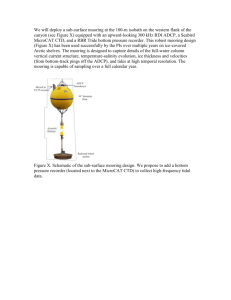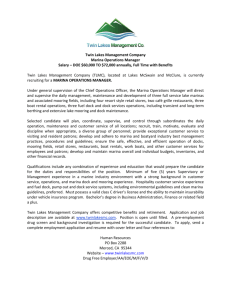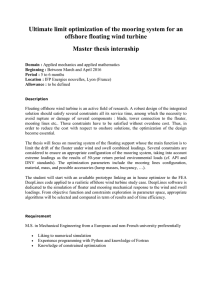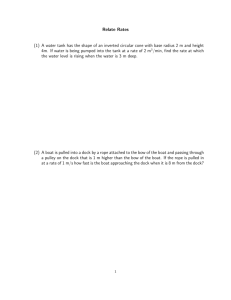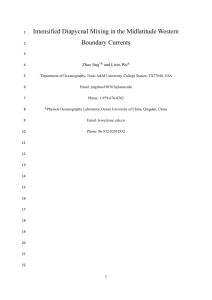Mooring Arms Installation
advertisement
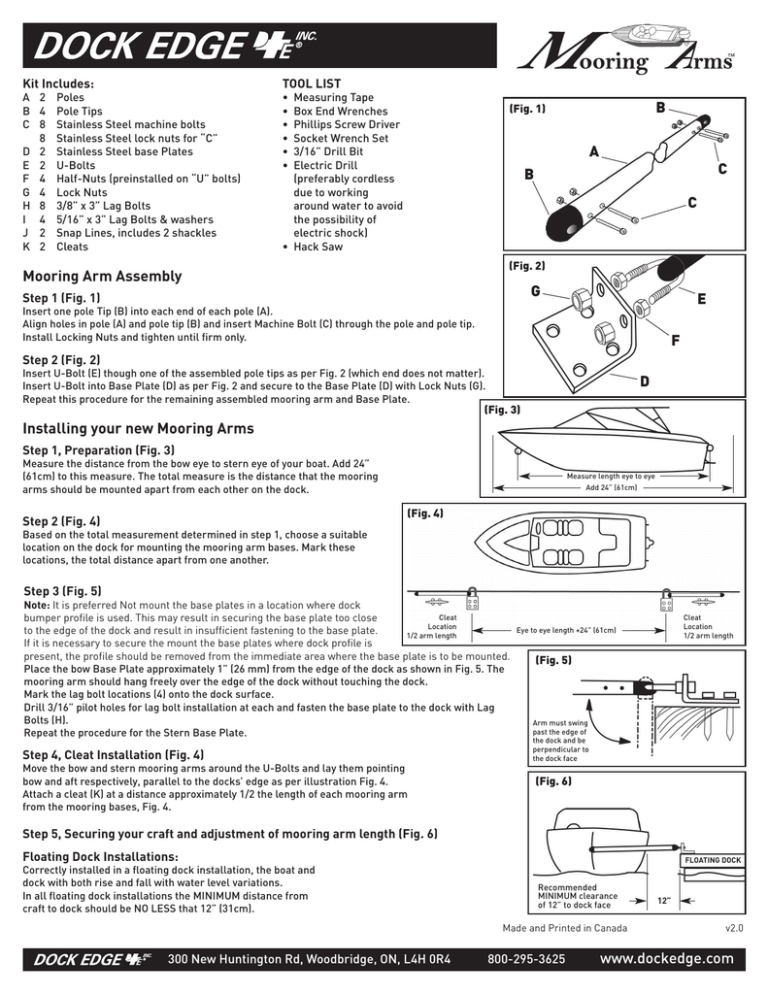
™ Kit Includes: A B C D E F G H I J K 2 4 8 8 2 2 4 4 8 4 2 2 Poles Pole Tips Stainless Steel machine bolts Stainless Steel lock nuts for “C” Stainless Steel base Plates U-Bolts Half-Nuts (preinstalled on “U” bolts) Lock Nuts 3/8” x 3” Lag Bolts 5/16” x 3” Lag Bolts & washers Snap Lines, includes 2 shackles Cleats TOOL LIST • Measuring Tape • Box End Wrenches • Phillips Screw Driver • Socket Wrench Set • 3/16” Drill Bit • Electric Drill (preferably cordless due to working around water to avoid the possibility of electric shock) • Hack Saw B (Fig. 1) A C B C (Fig. 2) Mooring Arm Assembly G Step 1 (Fig. 1) E Insert one pole Tip (B) into each end of each pole (A). Align holes in pole (A) and pole tip (B) and insert Machine Bolt (C) through the pole and pole tip. Install Locking Nuts and tighten until firm only. F Step 2 (Fig. 2) Insert U-Bolt (E) though one of the assembled pole tips as per Fig. 2 (which end does not matter). Insert U-Bolt into Base Plate (D) as per Fig. 2 and secure to the Base Plate (D) with Lock Nuts (G). Repeat this procedure for the remaining assembled mooring arm and Base Plate. D (Fig. 3) Installing your new Mooring Arms Step 1, Preparation (Fig. 3) Measure the distance from the bow eye to stern eye of your boat. Add 24” (61cm) to this measure. The total measure is the distance that the mooring arms should be mounted apart from each other on the dock. Measure length eye to eye Add 24” (61cm) (Fig. 4) Step 2 (Fig. 4) Based on the total measurement determined in step 1, choose a suitable location on the dock for mounting the mooring arm bases. Mark these locations, the total distance apart from one another. Step 3 (Fig. 5) Note: It is preferred Not mount the base plates in a location where dock Cleat bumper profile is used. This may result in securing the base plate too close Location to the edge of the dock and result in insufficient fastening to the base plate. 1/2 arm length If it is necessary to secure the mount the base plates where dock profile is present, the profile should be removed from the immediate area where the base plate is to be mounted. Place the bow Base Plate approximately 1” (26 mm) from the edge of the dock as shown in Fig. 5. The mooring arm should hang freely over the edge of the dock without touching the dock. Mark the lag bolt locations (4) onto the dock surface. Drill 3/16” pilot holes for lag bolt installation at each and fasten the base plate to the dock with Lag Bolts (H). Repeat the procedure for the Stern Base Plate. Step 4, Cleat Installation (Fig. 4) Move the bow and stern mooring arms around the U-Bolts and lay them pointing bow and aft respectively, parallel to the docks’ edge as per illustration Fig. 4. Attach a cleat (K) at a distance approximately 1/2 the length of each mooring arm from the mooring bases, Fig. 4. Cleat Location 1/2 arm length Eye to eye length +24” (61cm) (Fig. 5) Arm must swing past the edge of the dock and be perpendicular to the dock face (Fig. 6) Step 5, Securing your craft and adjustment of mooring arm length (Fig. 6) Floating Dock Installations: Correctly installed in a floating dock installation, the boat and dock with both rise and fall with water level variations. In all floating dock installations the MINIMUM distance from craft to dock should be NO LESS that 12” (31cm). FLOATING DOCK Recommended MINIMUM clearance of 12” to dock face Made and Printed in Canada 300 New Huntington Rd, Woodbridge, ON, L4H 0R4 800-295-3625 12” v2.0 www.dockedge.com ™ Stationary Dock Installations: Correctly installed in a stationary dock installation, the dock will not rise and fall with water level variations as it does with a floating dock. For this reason it must be determined what that maximum change in water level may be. The MINIMUM distance from dock to boat at either maximum or minimum water levels should be NO LESS than 12” (31cm). STATIONARY PIPE DOCK (Fig. 7) High Water Level IMPORTANT: Ensure a MINIMUM clearance of 12” from watercraft to dock face at low water levels. 12” Note: It may be desirable to shorten one or both mooring arm lengths for one of the following reasons. 1.To keep the boat parallel with the docks edge, example; stern eye is not the center line of the boat. 2.To allow the entire boat to be closer to the docks edge yet no closer than 12” (31cm) 3.For use on PWCs or other small craft. Low Water Level (Fig. 8) To Shorten a Mooring Arm 1.Measure from the center of the stern to the eye to which the mooring arm WILL be attached, Fig 8. This is the measurement/ length that must be cut from that mooring arm. 2.Remove the stern arm from the Base Plate by removing the Stainless Steel thru-bolts and lock nuts. 3.Using the measurement from (1), measure from the end without the pole tip and mark that length from the end of the mooring arm. 4.Using a fine-tooth saw or hack-saw, cut the mooring arm at this location. 5.Using the pole tip as a template Fig. 9, mark and drill new holes in the mooring arm to accommodate the pole tip. Note: If possible a drill press is preferable to keep the holes in line and on center through the tube. 6.Install the pole tip into the pole, align the holes and reinstall the Stainless Steel screws and lock nuts. IMPORTANT: If the stern arm has been shortened, it will be necessary to remount the dock cleat for the stern arm as well to reflect the shorter mooring arm length. Setting the Mooring Arms for the boat 1.Tie a knot in each snap line (J), so that from the knot to the end of the snap clip is 12” (31cm) Fig. 10 2.Thread the free end of the snap line through the mooring arm tip until the knot is stopped at the tip. 3.Align the mooring arm to a 90º angle (right angle) with the docks edge and tie off the snap line onto the cleat for that mooring arm to retain the 90º angle. 4.Repeat the procedure for the remaining mooring arm. Using your Mooring Arms Measure (Fig. 9) Pole DRILL PARALLEL Pole Tip IMPORTANT: Ensure holes are parallel to each other and perpendicular to the pole when drilling. (Fig. 10) 1 2 3 12” Mooring: 1.Clip the stern snap line onto the stern eyelet 2.Swing the stern mooring arm out until it engages with the knot 12” (31cm) behind the snap clip. This should place the stern mooring arm at 90º and perpendicular to the docks edge. 3.Clip the bow snap line to the bow eyelet and draw the snap line toward the dock and away from the boat. This will cause the bow mooring arm to slide on the snap line towards the boat and pull the boat away from the dock until it too engages the knot behind the snap clip. 4.Pull the bow snap line taught and secure to the bow mooring cleat on the dock. This should cause both mooring arms to now be at 90º (right angles) to the dock edge. Fig. 11. The watercraft is now safely moored and will freely follow water level variations, wakes, waves and tidal movement. Casting Off: It is only necessary to uncleat one snap line to allow casting off. 1.Uncleat the bow snap line from the dock. 2.Pulling upward on the bow mooring arm will cause the boat to approach the dock. 3.Unsnap the bow snap clip and lay the arm and snap line on the dock for your return. 4.Unsnap the stern snap clip. It is not necessary to uncleat the stern line. Lay the stern mooring arm and snap line on the dock for reattachment upon your return. TIPS To avoid losing snap lines, it’s suggested that a knot be tied in the snap line between the mooring arm tip(s) and closer to the dock cleat. This will prevent the snap line from sliding through the mooring eye and sinking. Frequently inspect the mooring arms and components for wear, looseness or damage. Replace components as required. 300 New Huntington Rd, Woodbridge, ON, L4H 0R4 (Fig. 11) 90º MINIMUM 12” 800-295-3625 www.dockedge.com
